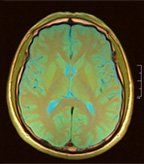Bone Metastases in Lung Cancer Patients Linked With Poorer Prognosis
A pair of studies from the ASCO annual meeting examined bone metastases from lung cancer, with one study finding that survival in patients was poorer in patients with bone metastases, and another study finding that the development of bone metastases could predict subsequent development of metastasis in the brain.
Bone metastasis is frequently observed in patients with advanced lung cancer. Several studies published online as part of the American Society of Clinical Oncology (ASCO) annual meeting reported on the incidence and clinical impact of bone metastases in lung cancer.

Brain MRI in a patient with lung cancer and brain metastases; Image:
© Nevit Dilmen
Researchers from the University of Ottawa in Ottawa, Ontario, Canada, found that bone metastases are common in patients with non–small-cell lung cancer (NSCLC). These patients frequently require opioids and have a significantly shorter survival.
The study authors retrospectively reviewed charts of 374 patients with NSCLC at the University of Ottawa in 2007. The median age of patients was 68, and 91% of the patients were current or previous smokers. The most frequent histology among patients was adenocarcinoma (36%) followed by squamous histology (18%). The vast majority of the patients had either stage III or stage IV disease at diagnosis.
Of the 301 patients who had metastatic NSCLC, 39% had bone lesions, 30% had brain metastases and 24% had liver lesions. Patients who had bone metastases tended to be older than age 70. Fifty-nine percent of these patients had skeletal-related events. Two or more skeletal-related events were associated with smoking status and a younger age. The overall survival of patients with bone metastases was 5.5 months compared with 9.9 months for those without bone lesions (P = .02).
Another study also published online as part of the ASCO annual meeting from researchers at the Karmanos Cancer Institute in Detroit, Michigan analyzed the association between bone and brain metastases in lung cancer patients.
Analyzing retrospective data of NSCLC patients with stage IV disease but no brain metastasis at diagnosis, the study found that among 175 patients (median age of 60 years), the development of bone metastases could predict subsequent development of metastasis in the brain. Thirty-four percent of the patients had bone metastases, and 79% received bevacizumab as part of their treatment. Those who already had bone metastases developed additional bone lesions more frequently compared with patients who did not have cancer in the bone at initial diagnosis (39% vs 19%, respectively, P = .01).
Among patients who initially had bone lesions, brain metastases developed in 33% of patients who developed new bone lesions, and in 6% of patients who did not develop further bone lesions.
When adjusted for bone lesions at diagnosis, development of new bone lesions was associated with a shorter time to brain metastasis (P = .005). The study also found that those treated with bevacizumab had less frequent development of new bone and brain metastases compared with those who did not receive the treatment. Within 2 years of starting bevacizumab, the chance of developing bone metastases was 27% for those treated with the antibody compared with 43% in those who did not receive the drug. Similarly, 25% of those on bevacizumab developed brain metastases compared with 33% not taking the drug.
Newsletter
Stay up to date on recent advances in the multidisciplinary approach to cancer.